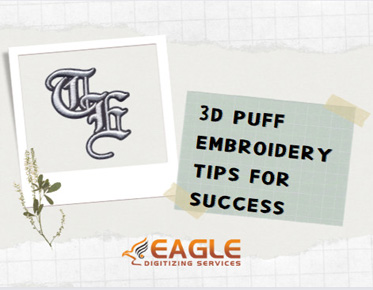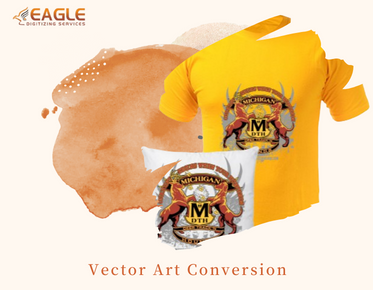Elevate Designs: Understanding 3D Puff Embroidery
A Quick Overview of 3D Puff Embroidery
3D puff embroidery is an advanced technique that adds a
three-dimensional effect to embroidered designs
by incorporating foam under the stitching. This method creates raised elements
that stand out from the fabric, giving the design a bold, textured appearance.
It's particularly popular for logos and lettering, making them more visually
striking.
Why 3D Puff Embroidery is trending?
The resurgence of 3D puff embroidery can be attributed to its unique
aesthetic and the added dimension it brings to custom apparel. As brands strive
to differentiate themselves in a crowded market, the eye-catching appeal of 3D
puff embroidery helps logos and designs pop. This trend is especially prevalent
in streetwear, sports apparel, and promotional merchandise.
The
Basics of 3D Puff Embroidery
Understanding the Concept of 3D Puff
At its core, 3D puff embroidery involves placing a foam layer under
the embroidery stitches. The foam elevates the
stitches, creating a raised effect that adds depth and texture to the design.
This technique requires precise digitizing to ensure the stitches cover the
foam adequately without compressing it too much.
How 3D Puff Embroidery Differs from
Traditional Embroidery
Unlike traditional flat embroidery, 3D puff embroidery uses foam to create a raised surface. This difference not only alters the visual impact but also the feel of the design. Traditional embroidery is typically flat and lies flush with the fabric, whereas 3D puff embroidery adds a tactile dimension that makes designs stand out.
Benefits
of 3D Puff Embroidery
Adding Depth and Dimension to Your
Designs
One of the primary benefits of 3D puff embroidery is the added depth
it brings to designs. The raised elements create a dynamic, three-dimensional
look that can make logos and artwork more engaging and memorable.
Enhancing Visual Appeal and Texture
The textured appearance of 3D puff embroidery enhances the visual
appeal of any garment. The raised stitches catch light differently than flat
embroidery, adding an extra layer of visual interest and sophistication to the
design.
Boosting Brand Recognition with
Unique Designs
Unique, eye-catching designs are crucial for brand recognition. 3D puff embroidery helps logos stand out, making them more noticeable and memorable. This distinctive look can give brands a competitive edge, especially in markets where visual differentiation is key.
Choosing
the Right Materials for 3D Puff Embroidery
Selecting the Best Foam for 3D Puff
The choice of foam is critical for achieving the desired 3D effect.
High-density foam works best as it provides sufficient support for the stitches
without collapsing. It's available in various thicknesses, allowing for
customization based on the design requirements.
Ideal Fabric Choices for 3D Puff
Embroidery
Certain fabrics lend themselves better to 3D puff embroidery. Stable,
non-stretch fabrics like cotton twill, denim, and canvas are ideal as they
provide a solid foundation for the foam and stitches. Avoid lightweight or
stretchy materials, as they may not support the raised embroidery effectively.
Importance of Quality Threads
Using high-quality threads ensures that the embroidery is durable and visually appealing. Polyester threads are particularly suitable for 3D puff embroidery due to their strength and colorfastness. They maintain their sheen and integrity even after repeated washing.
Designing
for 3D Puff Embroidery
Tips for Creating Effective 3D Puff
Designs
Effective 3D puff designs should be bold and simple. Fine details can
get lost in the foam, so it's best to focus on larger shapes and clean lines.
Consider the foam thickness when designing to ensure the stitches adequately
cover and define the raised areas.
Simplifying Complex Designs for
Better Results
Complex designs need to be simplified for 3D puff embroidery. Reducing
intricate details and focusing on the core elements of the design will help
achieve a more defined and impactful result. This simplification also helps in
maintaining the structural integrity of the embroidery.
Common Design Mistakes to Avoid
Avoiding common mistakes like using thin lines and overly detailed elements can enhance the success of 3D puff embroidery. Ensuring sufficient stitch coverage and proper foam placement are also critical to avoid gaps and uneven surfaces.
The
Process of 3D Puff Embroidery Digitizing
Step-by-Step Guide to Digitizing 3D
Puff Designs
Digitizing for 3D puff embroidery involves several key steps. First, the
design is imported into digitizing software. Next, underlay stitches are mapped
out to create a foundation for the foam. The main stitches are then added,
ensuring they cover the foam completely. Finally, finishing stitches are
applied to secure the design.
Key Software Tools for Digitizing
Specialized embroidery digitizing software
like Wilcom and Hatch is essential for creating accurate 3D puff designs. These
tools allow digitizers to control stitch types, directions, and densities,
ensuring the final embroidery looks polished and professional.
Understanding Stitch Types and Their
Roles
Different stitch types play specific roles in 3D puff embroidery. Underlay stitches create a foundation, satin stitches are often used for their smooth, raised appearance, and topping stitches help secure the foam. Each stitch type must be carefully planned to achieve the desired 3D effect.
Techniques
for Successful 3D Puff Embroidery
Perfecting the Underlay Stitches
Underlay stitches are crucial in 3D puff embroidery. They provide a
stable base and help prevent the foam from shifting. A well-planned underlay
ensures the final stitches are smooth and evenly raised.
Tackling the Foam Placement
Proper foam placement is essential for a successful 3D effect. The
foam should be positioned accurately beneath the design area. It's also
important to choose the right thickness of foam to match the design's
dimensions and complexity.
Finishing Touches for a Polished Look
Finishing touches include trimming excess foam and applying topping stitches to secure the design. These steps help achieve a clean, polished look and ensure the durability of the embroidery.
Common
Challenges in 3D Puff Embroidery
Overcoming Design Distortions
Design distortions can occur if the foam shifts or the stitches are
too tight. Ensuring proper hooping and tension settings can help minimize these
issues, resulting in a more accurate and professional-looking design.
Managing Foam Thickness and Density
Choosing the right foam thickness and density is critical. Too thick
or dense foam can make the embroidery stiff and uncomfortable, while too thin
foam may not provide the desired 3D effect. Testing different foams and
adjusting designs accordingly can help find the optimal balance.
Troubleshooting Common Issues
Common issues in 3D puff embroidery include foam showing through stitches and uneven surfaces. These problems can often be resolved by adjusting stitch densities, ensuring proper foam placement, and using high-quality materials.
Selecting
the Right Embroidery Machine
Features to Look for in a 3D Puff
Embroidery Machine
When selecting an embroidery machine for 3D puff work, look for
features like adjustable hoop tension, high stitch speeds, and compatibility
with thick materials. Machines with precise stitch control and advanced
digitizing capabilities are ideal for achieving high-quality results.
Top Embroidery Machines for 3D Puff
Top machines for 3D puff embroidery include the Brother PR1055X,
Janome MB-7, and the Tajima TMBP-SC series. These models offer the features
needed for professional-quality 3D puff designs, including multiple needle
options and robust software support.
Maintenance Tips for Longevity
Regular maintenance is crucial for keeping your embroidery machine in top condition. Clean the machine regularly, oil moving parts as recommended, and schedule professional servicing to ensure longevity and consistent performance.
DIY
vs. Professional 3D Puff Embroidery
Pros and Cons of Doing It Yourself
DIY 3D puff embroidery offers creative freedom and potential cost
savings. However, it requires a significant investment in equipment and
materials, along with a steep learning curve. For those with the time and
interest, it can be a rewarding hobby or business venture.
When to Consider Professional Services
Professional services are ideal when you need high-quality, consistent
results, especially for large orders or complex designs. Experienced
embroiderers can ensure your designs are digitized and executed perfectly,
saving you time and effort.
Cost Considerations for DIY vs.
Professional Work
DIY embroidery may have lower upfront costs, but professional services offer value in terms of quality and efficiency. Consider the scale of your project and your own skill level when deciding which route to take.
Caring
for 3D Puff Embroidered Items
Proper Cleaning Techniques
To clean 3D puff embroidered items, hand wash or use a gentle cycle
with mild detergent. Avoid harsh chemicals and high heat, as they can damage
the foam and stitches. Air drying is preferable to maintain the shape and
integrity of the design.
Storage Tips to Maintain Shape and
Texture
Store 3D puff embroidered items in a cool, dry place. Avoid folding or
compressing the foam, as this can distort the design. Hanging or laying items
flat helps maintain their shape and texture.
Repairing Damaged 3D Puff Embroidery
Minor damages can be repaired by carefully restitching the affected areas. For more significant issues, consider seeking professional repair services. Maintaining proper care routines can help prevent damage and prolong the lifespan of your embroidered items.
Creative
Uses for 3D Puff Embroidery
Custom Apparel: Hats, Jackets, and
More
3D puff embroidery is perfect for custom apparel, including hats,
jackets, and hoodies. The raised designs add a touch of luxury and uniqueness
to everyday items, making them ideal for branding or personal expression.
Branding Merchandise with 3D Puff
Logos
Branded merchandise like bags, caps, and shirts can benefit from 3D
puff logos. The dimensional effect draws attention and enhances brand
visibility, making it a popular choice for promotional products.
Unique Gifts and Personal Projects
3D puff embroidery is also great for creating unique gifts and personal projects. Customized items like monogrammed towels, personalized bags, and decorative pillows can feature intricate, raised designs that stand out.
Trends
in 3D Puff Embroidery
Latest Techniques and Styles
Current trends in 3D puff embroidery include combining different
textures, such as mixing flat and 3D elements and using metallic threads for
added shimmer. These techniques push the boundaries of traditional embroidery
and offer fresh, modern looks.
The Rise of Eco-Friendly Materials
Eco-friendly materials are gaining traction in 3D puff embroidery.
Sustainable threads, organic fabrics, and biodegradable foams are becoming more
popular as consumers and brands prioritize environmental responsibility.
Future Directions in 3D Puff
Embroidery
Future directions for 3D puff embroidery include advancements in digitizing software, more sophisticated machinery, and innovative materials that expand the possibilities for creative designs. The integration of smart textiles and wearable technology may also play a role in the future of embroidery.
3D puff embroidery offers unique benefits, including added depth, enhanced visual appeal, and improved brand recognition. Its versatility makes it suitable for a wide range of applications, from custom apparel to branding merchandise and personal projects.
Exploring 3D puff embroidery can open new creative possibilities for
designers and businesses alike. Whether you're looking to enhance your brand or
create standout custom items, 3D puff embroidery provides a dynamic and
impactful solution.



